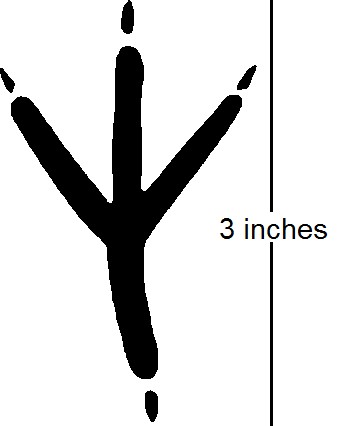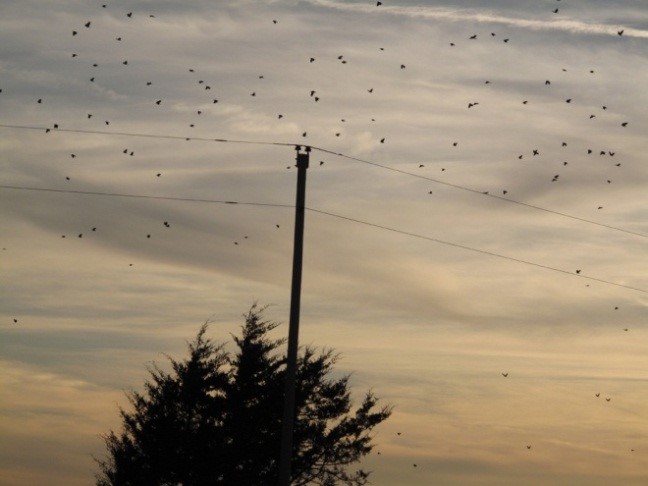Editors note: The following research summary describes a new article in The Auk, the journal of the Cooper Ornithological Society, and was provided by the Central Ornithology Publication Office.
Partial migrationwhere some individuals within a population migrate and some dontis common among birds and is speculated to be a step on the evolutionary path to complete, long-distance migration, but scientists know very little about how it actually works. A new study from The Auk: Ornithological Advances tracks where American Crows go during the winter and shows that while individuals are consistent in whether they migrate or stay put, partial migration might give them enough flexibility to adapt to changing environmental conditions.
Hamilton Colleges Andrea Townsend and her colleagues captured crows in large winter flocks in Utica, New York, and Davis, California, fitting them with satellite transmitters to track their movements and collecting blood and feather samples. Their data show that 73% of western crows and 86% of eastern crows migrated at least some distance to breed, with an average journey of around 500 kilometers. Birds returned faithfully to the same breeding territory each year, and whether or not individuals migrated was consistent from one year to the nextthey didnt switch strategies depending on environmental conditions. However, they were flexible in where they spent the winter.
This information can serve as an important baseline for tracking how crows migratory behavior is affected by factors including climate change and urbanization. Urban heat islands, as well as general warming trends, could lead more birds to shorten their migration and spend the winter closer to their breeding territory. If you live in a place, usually a city, with a huge winter flock of crows, you are seeing migratory birds that came south for the winter as well as your local, year-round crows, says Townsend. Personally, I find the sight of an 8000-crow roost exhilarating, but if they or their feces are driving you crazy, you can at least take comfort in knowing that most of them will disappear in early March.
It is surprising how much remains unknown about the seasonal movements of most partial migrant species, and this is especially true for variability among populations, adds the Smithsonian Migratory Bird Centers Emily Cohen, an expert on migration patterns who was not involved with the study. This kind of information about populations-specific annual movements is not trivial to collect, but is fundamental to understanding most aspects of the evolution and ecology of species.
About the journal: The Auk: Ornithological Advances is a peer-reviewed, international journal of ornithology published by the American Ornithological Society. The Auk commenced publication in 1884 and in 2009 was honored as one of the 100 most influential journals of biology and medicine over the past 100 years. The Auk has the #1 average Journal Impact Factor for the past 5 years for ornithology journals.
Voice, Sounds, Tracks, and Signs
American crows call out in a variety of ways, one of which is a warning cry known as “caw, caw.” Crows have been trained to mimic human voices and can mimic the sounds made by other birds and animals. Fish crows make a short, nasal “ca,” “car,” or “ca-ha” sound when they call. .
Crows are easily recognized due to their gregarious behavior and frequent vocalizations. Tracks may be found in soft soils (Figure 3).

The extent and kind of damage varies greatly between locations and years. When crows are looking for worms and other invertebrates in the grass, they may rip up the turf. Large roosts can foul areas with their excrement.
All About Birds is a free resource
Available for everyone, funded by donors like you
American Kestrel by Blair Dudeck / Macaulay Library Search for species name or keywords
Or Browse Bird Guide by Family or Shape
Need Bird ID Help? Try Merlin
Health and Safety Concerns
When crows and their roosts are in the vicinity of airports, it could be dangerous for airplanes to fly near them.
In certain instances, sizable crow flocks may contribute to the spread of disease. Crows feeding in and near swine housing buildings have been linked to the transmission of transmissible gastroenteritis (TGE). Crows are more likely to spread avian cholera because of their scavenging behavior and the apparent longer incubation period for the disease in crows.
Crow, blackbird, and starling roosts that have been occupied for a number of years may be home to the histoplasmosis-causing fungus Histoplasma capsulatum. When soils at a roost site are disturbed, airborne spores from the disease can infect humans. Due to their high susceptibility to the West Nile Virus (WNV), American crows are believed to play a role in the virus’s quick spread throughout the country. WNV can also infect fish crows, although their survival rate is higher.
American crows are capable of breeding after 2 years. Crows nest in February to May in the northeast. At least in non-migratory populations, mates seem to stay together all year long. They maintain pair bonds, even in large winter migratory flocks. Both sexes build the nest and feed the young. Occasionally, juveniles (nest associates) help with nesting activities. The male and other members of the nest provide food for the female while she incubates the eggs. Usually one brood is produced per year. 4 to 6 eggs make up the typical clutch size, and they hatch in roughly 18 days. About 30 days after hatching, the young fledge and spend the summer foraging with their parents.
The success rate of nests is lowest in urban populations, with an average of just one fledging per brood. With an average of 1, rural crows have the highest nest success rate. 6 young per brood. Brood loss can be caused by a number of things, such as starvation, unfavorable weather, and predation by raccoons (Procyon lotor) and great horned owls (Bubo virginianus).
Nests are lined with shredded bark, feathers, grass, fabric, and string and are made of twigs, sticks, and coarse stems. They typically live in trees that are 18 to 60 feet above the ground. Nests rarely are located in deep forests. Crows may build their nests on the ground or on telephone pole crossbars in areas with little trees.
Because they live in areas where people have an influence, crows are regarded as commensal. Crows seldom breed farther than three miles from human-habitat areas. Historically, fire suppression, which promotes the growth of trees for roosting, and agriculture, which provides food, have helped crow populations.
Crows are among the most intelligent of birds. American crows have excellent problem-solving skills, strong memories, a wide variety of vocalizations, and the ability to quickly associate particular noises and symbols with food. They can also count to three or four. According to one account, an American crow dumped palm nuts onto a residential street and watched for oncoming cars to break them.
The quantity of crows that forage along highways compared to the number of crows struck by cars may indicate that crows are cautious birds.
Crows often post a sentinel while feeding. Research suggests that the sentinel might belong to a family group, but the presence of the sentinel is probably advantageous to nearby crows and other birds.
According to research, roosting crows may move in two different daily patterns. Some take daily flights to a 24-hour activity center run by four or five birds. Usually, members of the groups take different flights and stop at different locations. Other crows don’t seem to be attached, and they don’t seem to have stable groups or regular, focused activity centers. The solitary birds, who may be migrants, feed at locations like landfills because they are not devoted to one particular area.
While some wild crows have reached the age of 14, others have lived for over 20 years in captivity, very few wild crows survive longer than six years. One researcher reported a wild crow that lived 29 years. Large hawks and owls are the only other predators that occasionally prey on adult crows.
Crow behavior includes gathering into large flocks in the fall and winter, which is a noteworthy and impressive display (Figure 2). As the season goes on, numerous small flocks gradually come together to form large flocks, with the highest concentrations happening in late winter. Every winter, tens of thousands of crows gather at a communal roost in the Auburn area of central New York. Crows frequently roost in towns in a number of other states, which has led to differing views on how to handle them. Crowds gather to roost together at night, and they can travel up to 6 to 12 miles daily to find food.

The habitats that American crows prefer are woodlots with trees for roosting and nesting, and open fields where food can be found. They frequently inhabit woodlots, farms, orchards, parks, wooded areas beside streams and rivers, and suburban areas. When choosing a tree to roost in, American crows look for larger trees with more canopy cover than other trees. They also look for locations with high levels of nighttime light and that are less than two miles from food sources.
Crows are omnivorous. They eat almost anything, and they easily modify their foraging techniques to take advantage of shifting food sources and seasonal variations. They appear equally adept at hunting, pirating, and scavenging. Crows consume over 600 different food items.
Animal matter, such as grasshoppers, beetles, beetle larvae (white grubs, wireworms), caterpillars, spiders, millipedes, dead fish, frogs, salamanders, snakes, eggs, young birds, and carrion, makes up about ? of the crows yearly diet. One of the main sources of food, especially in cities, is garbage. Their remaining food is made up mostly of vegetables and plant material, mostly corn that is harvested from fields. Acorns, wild and farmed fruits, watermelon, wheat, sorghum, peanuts, and pecans are among the other foods that crows eat.
FAQ
Are crows protected under the Migratory Bird Act?
Are crows migratory birds?
Why do crows not fly south for the winter?
Where do the crows go in the summer?